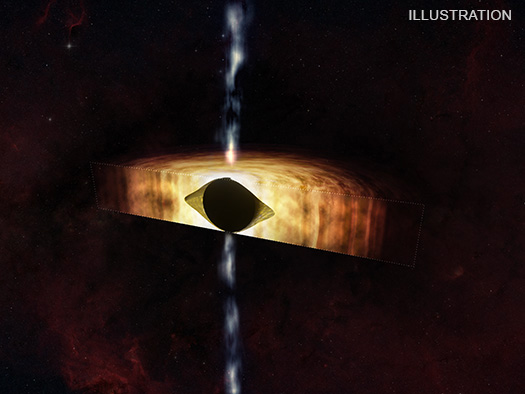Chandra Ties Powerful Black Hole to Stellar Beads-on-a-String

Osase Omoruyi with her parents’ favorite beads.
We are happy to welcome Osase Omoruyi as a guest blogger. Osase is the first author of the paper that is the focus of our latest press release, and is an NSF Graduate Research Fellow at Harvard University, where she is currently completing her PhD in Astronomy and Master’s in History of Science. Osase uses a variety of telescopes, from X-ray through Radio, as well as computer simulations, to study the fascinating life of galaxies. She is particularly interested in how stars and black holes, which are small in comparison to the scale of a whole galaxy, can transform how galaxies change over time.
In 2008, astronomers using the Wisconsin–Indiana–Yale NOAO (WIYN) telescope in Arizona published images of the newly discovered galaxy cluster named SDSS J1531+3414 (SDSS J1531 for short). At first glance, it seemed like a standard massive cluster of galaxies with one giant galaxy in its center, hundreds of others surrounding it, and arc-like structures caused by gravitational lensing – a phenomenon where the cluster's gravity bends light from galaxies behind it.
However, our understanding of SDSS J1531 changed dramatically in 2014 when the Hubble Space Telescope provided a higher-resolution view of the cluster from space. Contrary to initial beliefs, the heart of the cluster housed not one but two massive galaxies, on course to collide and merge into a single entity. They also featured 19 clusters of young stars wrapped around them in a pattern that resembled beads on a string.
Stellar Beads on a String
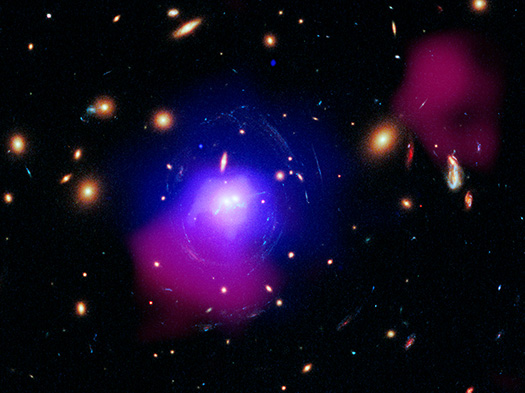
SDSS J1531+3414
Credit: X-ray: NASA/CXC/SAO/O. Omoruyi et al.; Optical: NASA/ESA/STScI/G. Tremblay et al.;
Radio: ASTRON/LOFAR; Image Processing: NASA/CXC/SAO/N. Wolk
Astronomers have discovered one of the most powerful eruptions from a black hole ever recorded in the system known as SDSS J1531+3414 (SDSS J1531 for short). As explained in our press release, this mega-explosion billions of years ago may help explain the formation of a striking pattern of star clusters around two massive galaxies, resembling “beads on a string.”
SDSS J1531 is a massive galaxy cluster containing hundreds of individual galaxies and huge reservoirs of hot gas and dark matter. At the center of SDSS J1531, which is located about 3.8 billion light-years away, two of the cluster’s largest galaxies are colliding with each other.
Astronomers used several telescopes to study SDSS J1531 including NASA’s Chandra X-ray Observatory, and the Low Frequency Array (LOFAR), a radio telescope. This composite image shows SDSS J1531 in X-rays from Chandra (blue and purple) that have been combined with radio data from LOFAR (dark pink) as well as an optical image from the Hubble Space Telescope (appearing as yellow and white). The inset gives a close-in view of the center of SDSS J1531 in optical light, showing the two large galaxies and a set of 19 large clusters of stars, called superclusters, stretching across the middle. The image shows these star clusters are arranged in an ‘S’ formation that resembles beads on a string.
Telescopes Show the Milky Way's Black Hole is Ready for a Kick
This artist’s illustration depicts the findings of a new study about the supermassive black hole at the center of our galaxy called Sagittarius A* (abbreviated as Sgr A*). As reported in our latest press release, this result found that Sgr A* is spinning so quickly that it is warping spacetime — that is, time and the three dimensions of space — so that it can look more like a football.
These results were made with NASA’s Chandra X-ray Observatory and the NSF’s Karl G. Jansky Very Large Array (VLA). A team of researchers applied a new method that uses X-ray and radio data to determine how quickly Sgr A* is spinning based on how material is flowing towards and away from the black hole. They found Sgr A* is spinning with an angular velocity that is about 60% of the maximum possible value, and with an angular momentum of about 90% of the maximum possible value.
NASA's IXPE Helps Researchers Maximize 'Microquasar' Findings
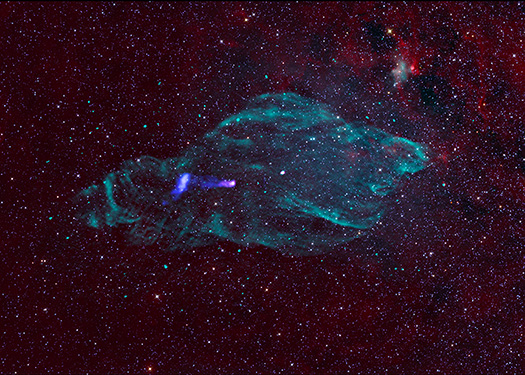
SS 433
Credit: X-ray: (IXPE): NASA/MSFC/IXPE; (Chandra): NASA/CXC/SAO; (XMM): ESA/XMM-Newton; IR: NASA/JPL/Caltech/WISE;
Radio: NRAO/AUI/NSF/VLA/B. Saxton. (IR/Radio image created with data from M. Goss, et al.);
Image Processing/compositing: NASA/CXC/SAO/N. Wolk & K. Arcand
This composite image of the Manatee Nebula captures the jet emanating from SS 433, a black hole pulling material inwards that is embedded in the supernova remnant which spawned it. Radio emission from the supernova remnant are blue-green, whereas the X-ray from IXPE, XMM-Newton and Chandra are highlighted in bright blue-purple and pink-white set against a backdrop of infrared data in red. The black hole emits twin jets of matter traveling in opposite directions at nearly the speed of light.
These jets distort the remnant’s shape into one astronomers dubbed the Manatee. The jets become bright about 100 light-years away from the black hole, where particles are accelerated to very high energies by shocks within the jet. The IXPE data shows that the magnetic field, which plays a key role in how particles are accelerated, is aligned parallel to the jet — aiding our understanding of how astrophysical jets accelerate these particles to high energies.
Astronomers Find Spark of Star Birth Across Billions of Years
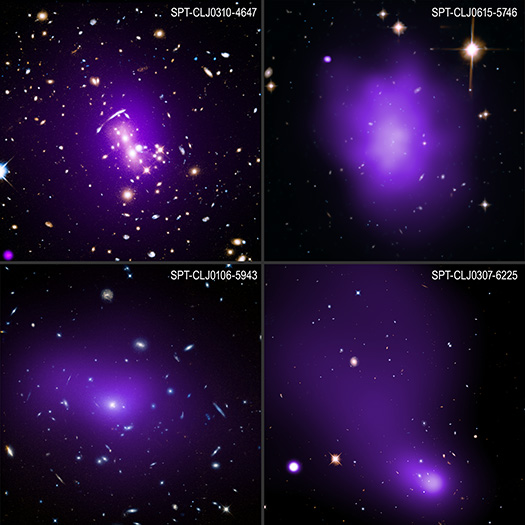
Brightest Cluster Galaxies Survey
Credit: X-ray: NASA/CXC/MIT/M. Calzadilla el al.; Optical: NASA/ESA/STScI;
Image Processing: NASA/CXC/SAO/N. Wolk & J. Major
These four images represent a sample of galaxy clusters that are part of the largest and most complete study to learn what triggers stars to form in the universe’s biggest galaxies, as described in our latest press release. This research, made using NASA’s Chandra X-ray Observatory and other telescopes, showed that the conditions for stellar conception in these exceptionally massive galaxies have not changed over the last ten billion years.
Galaxy clusters are the largest objects in the universe held together by gravity and contain huge amounts of hot gas seen in X-rays. This hot gas weighs several times the total mass of all the stars in all the hundreds of galaxies typically found in galaxy clusters. In the four galaxy cluster images in this graphic, X-rays from hot gas detected by Chandra are in purple and optical data from NASA’s Hubble Space Telescope, mostly showing galaxies in the clusters, are yellow and cyan.
NASA Telescopes Chase Down "Green Monster" in Star's Debris
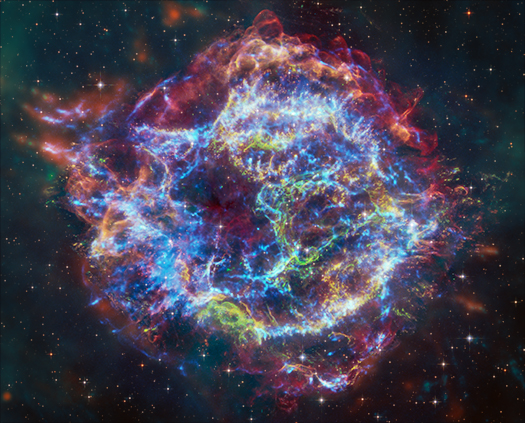
Cassiopeia A
Credit: X-ray: NASA/CXC/SAO; Optical: NASA/ESA/STScI;
IR: NASA/ESA/CSA/STScI/Milisavljevic et al., NASA/JPL/CalTech;
Image Processing: NASA/CXC/SAO/J. Schmidt and K. Arcand
For the first time astronomers have combined data from NASA’s Chandra X-ray Observatory and James Webb Space Telescope to study the well-known supernova remnant Cassiopeia A (Cas A). As described in our latest press release, this work has helped explain an unusual structure in the debris from the destroyed star called the “Green Monster”, first discovered in Webb data in April 2023. The research has also uncovered new details about the explosion that created Cas A about 340 years ago, from Earth’s perspective.
NASA Telescopes Start the Year With a Double Bang
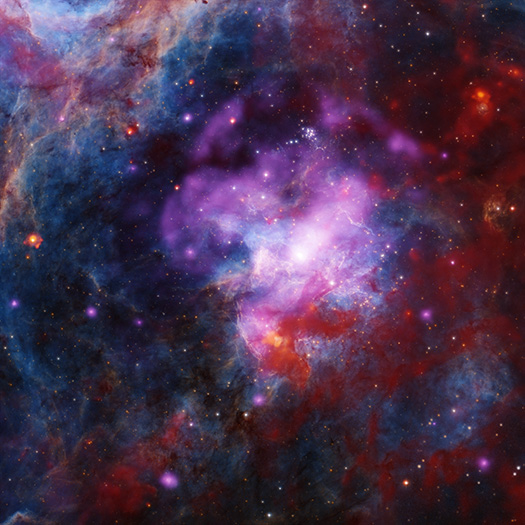
30 Doradus B
Credit: X-ray: NASA/CXC/Penn State Univ./L. Townsley et al.; Optical: NASA/STScI/HST; Infrared: NASA/JPL/CalTech/SST; Image Processing: NASA/CXC/SAO/J. Schmidt, N. Wolk, K. Arcand
A colorful, festive image shows different types of light containing the remains of not one, but at least two, exploded stars. This supernova remnant is known as 30 Doradus B (30 Dor B for short) and is part of a larger region of space where stars have been continuously forming for the past 8 to 10 million years. It is a complex landscape of dark clouds of gas, young stars, high-energy shocks, and superheated gas, located 160,000 light-years away from Earth in the Large Magellanic Cloud, a small satellite galaxy of the Milky Way.
The new image of 30 Dor B was made by combining X-ray data from NASA’s Chandra X-ray Observatory (purple), optical data from the Blanco 4-meter telescope in Chile (orange and cyan), and infrared data from NASA’s Spitzer Space Telescope (red). Optical data from NASA’s Hubble Space Telescope was also added in black and white to highlight sharp features in the image.
Sprightly Stars Illuminate 'Christmas Tree Cluster'
Your browser does not support the video tag.
This new image of NGC 2264, also known as the “Christmas Tree Cluster,” shows the shape of a cosmic tree with the glow of stellar lights. NGC 2264 is, in fact, a cluster of young stars — with ages between about one and five million years old — in our Milky Way about 2,500 light-years away from Earth. The stars in NGC 2264 are both smaller and larger than the Sun, ranging from some with less than a tenth the mass of the Sun to others containing about seven solar masses.
NASA's Chandra Catches Spider Pulsars Destroying Nearby Stars

Omega Centauri
Credit: X-ray: NASA/CXC/San Francisco State Univ./A. Cool et al.;
Optical: NASA/ESA/STScI; IR: NASA/JPL/Caltech; Image Processing: NASA/CXC/SAO/N. Wolk
A group of dead stars known as “spider pulsars” are obliterating companion stars within their reach. Data from NASA’s Chandra X-ray Observatory of the globular cluster Omega Centauri is helping astronomers understand how these spider pulsars prey on their stellar companions.
A pulsar is the spinning dense core that remains after a massive star collapses into itself to form a neutron star. Rapidly rotating neutron stars can produce beams of radiation. Like a rotating lighthouse beam, the radiation can be observed as a powerful, pulsing source of radiation, or pulsar. Some pulsars spin around dozens to hundreds of times per second, and these are known as millisecond pulsars.
Sensational New "Pro-Am" View of Cas A
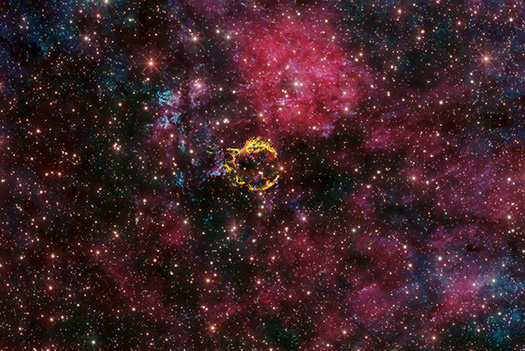
Cassiopeia A
Contributors: Tim Schaeffer, William Ostling, Justin,
Adrien Keijzer, Paul Kent, BTB Astroteam Brentenriegel, Steve Gill, Tino Heuberger,
Nicolas Puig, Julian Shapiro, Felix Schöfbänker, Mikhail Vasilev, David Wood
In sports, the term “pro-am” refers to a competition between professional and non-professional athletes. In astronomy, there are also “pro-am” events, but these are highly collaborative and never cutthroat.
AstroBin is an image hosting platform and social network for astrophotographers (also often known as “amateur astronomers”, though their skill and expertise should never be questioned!)

